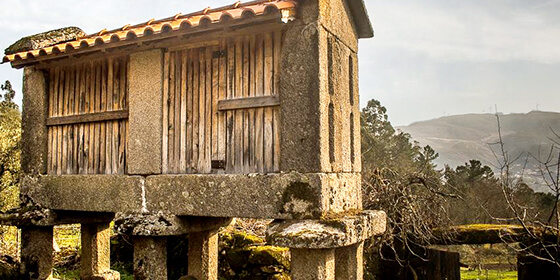THE LANDSCAPES OF
PORTUGAL
LET US SHARE OUR HOME WITH YOU!
The Peneda-Gerês National Park was created over 40 years ago with the vision to conserve these mountainous spaces while permitting human and natural resource activities, including educational, touristic, and scientific projects.

OVERVIEW
All 271 square miles (703 square kilometers) of Gerês are inhabited by humans but are highly regulated to ensure that the ecosystem is constantly supervised, nurtured, and carefully utilized to support conservancy.
Gerês is a stunning labyrinth of regenerating oak forests, undulating green valleys, peat bogs, 300 million-year-old granite mountains, and tranquil waters and around the park.

GEOGRAPHY
It spreads through an area of 110 square miles and includes the mountains of Amarela, Soajo, and Peneda and Gerês, the biggest of the mountains, which give the park its name.
Its boundaries are confined inside two regions, Minho and Trás-os-Montes, and the area belongs to three districts, Braga, Viana do Castelo, and Vila Real and five counties, Terras de Bouro, Arcos de Valdevez, Melgaço, Ponte da Barca, and Montalegre.

FLORA & FAUNA
Wildflowers bloom everywhere from spring to autumn, and they are so tiny that you have to pay attention not to step on them. Walking the same trail every day, you can spot different kinds blooms.
There are bushes all over the National Park, and some are very famous because you can make herbal tea with them. Hipericão and Carqueja are the most famous, but you can find more.
If you are lucky, you can spot an Ibex (mountain wild goat), or a wolf, but it’s really very difficult. You can spot butterflies and lizards everywhere, especially from spring to autumn.

WEATHER
In the winter, you can get some rainy days, around 20%, and snow about five days a year on the highest levels of the mountain. The temperatures range between 32ºF (0ºC) and 50ºF (10ºC).
Spring and autumn are mild with some rain and temperatures going from 46ºF (8ºC) to 73ºC (23ºC), and during the summer you have a minimum average temperature of 64ºF (18ºC) and a maximum of 86ºF (30ºC).

POPULATION & TRADITION
Mainly an agricultural and shepherd society, the population is old but strong. Their stubbornness grants them the will to win the mountains’ favor and allows them to harvest almost everything they consume.
Traditions centuries old are still visible, and the community acts as one huge organism. We can see that example in the community watermills and olive and wine presses, but the best example relates to the herding of animals.
A village is usually 150 inhabitants, and they have goat herds of nearly 500 animals. To herd them, they need just two men and a couple of dogs to keep the wolves away.
They use a rotating shift system called “vezeira” – one week two neighbors tend the herd, and the next week they will give the herd to two other neighbors and so on.
During spring and summer, shepherds roam the mountains all week sleeping in shelters called “Curral,” taking the goats from place to place and allowing the mountain pastures to renew. In autumn and winter, they will return every day to the village with the goats.
Besides goats, they have a special breed of cows easily mistaken with bulls due to their long horns. This breed is called “barrosã,” and although they look fierce, they are very friendly.
You can also find their shorter version called “cachena”, that the shepherds say its half goat because they can go where the goats go.

LANDSCAPE
The most visible thing in the National Park is water. It’s all over, and due to this fact, the Portuguese government created a series of power dams to produce electricity, that’s why we have big artificial lakes. Caniçada and Vilarinho das Furnas are the biggest and they allow special conditions for water sports like kayak, stand up paddle, canoeing, or just lying down on the sand to get a nice suntan.
There are also other sports that you can enjoy with a little more of adrenaline, like canyoning, and for this, you have one of the best spots, Arado River, with its amazing waterfalls and high jumps. In a series of different maneuvers like rappel, slide, and up sailing, you’ll have the perfect match between adrenaline, water, nature, and fun.
If you just want to have fun, you should try the Tahiti Waterfalls and the amazing Poço Azul – Blue Well – a turquoise blue natural swimming pool at the heart of Gerês. For this, it’s wise to hire a tour company to take you there – just look on TripAdvisor and you’ll find a couple doing day tours to the National Park.
Lima and Cavado rivers are good rivers to do whitewater canoeing, and Minho is good for beginner-level rafting.
You can find very different kinds of forest in a one-day tour in the mountains, from the high altitude pine forest, cypress in medium range mountains and the local Iberian forest, near the water streams, composed with three different kinds of oak, chestnut, firs, and willow. The best example for this is Mata de Albergaria, considered the oldest Portuguese forest.

GARRANOS, THE WILD HORSES
Wild horses still run free in Peneda-Gerês National Park in northeastern Portugal. About 1,600 of these small but hardy mountain-living horses roam in the park, but their numbers have dwindled because of wolves preying on the young horses.
The garrano breed was only officially recognized in 1993. The chestnut brown males stand about four feet high at the most. The garranos are well equipped to survive the mountainous terrain found in the northern hills. The pint-sized horses are believed to be the descendants of prehistoric horses such as the Equus Caballus, which roamed the northern Iberian Peninsula 1 million years ago.
But garranos have only one foal a year, with the maximum life expectancy of the breed averaging 30 years. The breed almost disappeared at the start of the 20th century, but in 1945, 21 garranos in captivity were selected and freed into the wild in the Serras Amarela and Gerês, with the objective of creating a reserve for them.
In 1970, the Peneda-Gerês National Park was created with the aim to protect the last wild group of garranos horses in existence. In 1994, the breed was classified by the European Union as a “breed under threat” and registration began of all remaining horses.

EATING
The most popular dish is Caldo Verde, chock full of kale, potatoes, garlic, and a massive chunk of chouriço. Portuguese chouriço is generally made with pork, fat, wine, paprika, garlic, and salt, which not only makes your house smell incredible when cooking with it, but it also adds the perfect amount of flavour to balance the kale.
Vinho Verde has traditionally been associated with light, low-alcohol, and often slightly fizzy wine. Vinho Verde whites have traditionally been made from a blend of grapes. There are over 30 indigenous white grapes in the Vinho Verde region, although seven in particular are viewed as most suitable for making the region’s whites: Avesso, Azal, Arinto, Batoca, Loureiro, Trajadura, and Alvarinho.
They are soft and light with a predominantly citrusy flavor and aroma profile. Acidity is high and alcohol levels are kept low. Vintages are not necessarily found on the bottle, and the wines are meant to be drunk young.




